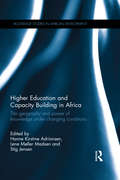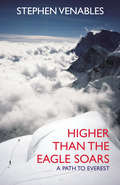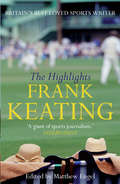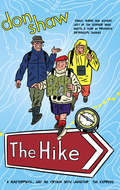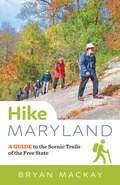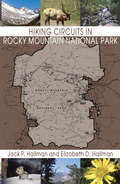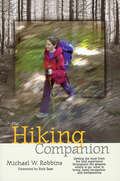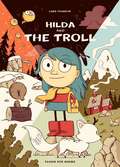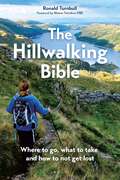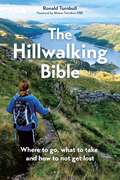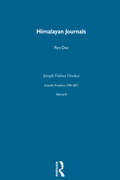- Table View
- List View
Higher Education and Capacity Building in Africa: The geography and power of knowledge under changing conditions (Routledge Studies in African Development)
by Hanne Kirstine Adriansen Lene Møller Madsen Stig JensenHigher education has recently been recognized as a key driver for societal growth in the Global South and capacity building of African universities is now widely included in donor policies. The question is; how do capacity building projects affect African universities, researchers and students? Universities and their scientific knowledges are often seen to have universal qualities; therefore, capacity building may appear straight forward. Higher Education and Capacity Building in Africa contests such universalistic notions. Inspired by ideas about the ‘geography of scientific knowledge’ it explores what role specific places and relationships have in knowledge production, and analyses how cultural experiences are included and excluded in teaching and research. Thus, the different chapters show how what constitutes legitimate scientific knowledge is negotiated and contested. In doing so, the chapters draw on discussions about the hegemony of Western thought in education and knowledge production. The authors’ own experiences with higher education capacity building and knowledge production are discussed and used to contribute to the reflexive turn and rise of auto-ethnography. This book is a valuable resource for researchers and postgraduate students in education, development studies, African studies and human geography, as well as anthropology and history.
Higher Than The Eagle Soars: A Path to Everest
by Stephen VenablesHigh and wild places have dominated Stephen Venables' life and now he has written a full autobiography which explores how and - more importantly - why he became a mountaineer, and reveals a series of never-recorded adventures on four continents. At its climax he revisits his dramatic success without oxygen on the Kangshung Face of Everest, described by Reinhold Messner as the most adventurous in Everest's history and by Lord Hunt as 'one of the most remarkable ordeals from which men or women have returned alive'. As Venables writes: 'Although we didn't go seeking deliberately an epic near-death experience, it did turn out that way - the ultimate endurance test for which all the previous adventures seemed, retrospectively, to be a preparation.'
Highland Homespun
by Margaret LeighIn May 1933 Margaret Leigh took over the tenancy of Achnabo farm, in a beautiful corner of the West Highlands overlooking the isle of Skye. In, Highland Homespun - this unsentimental yet exquisitely written book - she recounts a year of farming life there, from the burning of the land and ploughing in March, through planting and sowing in April to haymaking and harvesting in September. Incidental details - such as a visit to the smithy, the arrival of some new bulls and the annual journey of the cows to the summer shielings - provide fascinating insights into farming life. Local characters and customs feature too, adding another rich dimension to this reflective and poignant memoir of a world now vanished forever.
Highlands – Scotland’s Wild Heart: Scotland's Wild Heart
by Mr Stephen Moss Laurie CampbellIn the very north of Britain, far from the bustling cities and picturesque countryside to the south, lies Western Europe's greatest wilderness: the Scottish Highlands. This is a land shaped by the flow of ancient ice, where snow-capped mountains tower over ink-black lochs, Golden Eagles soar over heather-clad moors, and Red Deer stags engage in mortal combat for the right to win a mate. Along the coast, sea cliffs and offshore islands teem with millions of seabirds, while the seas themselves are home to Basking Sharks, Orcas and Bottlenose Dolphins. The Highlands may at first sight seem bleak and desolate, but they are also filled with secret wonders, from the ancient Caledonian pine forests to the vast Flow Country, and from the sheer granite cliffs of Handa to the mysterious depths of Loch Ness. In this lavish companion to the BBC TV series Stephen Moss's thoughtful, authoritative text is accompanied by spectacular photography from Laurie Campbell. Highlands – Scotland's Wild Heart follows a year in the lives of a stellar cast of wild animals as they live, feed, breed and die in this beautiful, yet unforgiving landscape – a land where only the toughest survive.
The Highlights: The Best of Frank Keating
by Frank KeatingFrank Keating's work adorned the Guardian for four decades from 1973 until shortly before his death in early 2013. In his heyday Keating's fizzing wordplay and sheer joie de vivre thrilled readers. They saw him not just as a journalist but as a fan who shared their own delight in sport for its own sake and in the stars who made it watchable. He also had a special rapport with many of the greats such as Barry John and Ian Botham. From the 1970s to the 1990s he attended nearly all the great sporting events. Later he became a nostalgist with a matchless gift for bringing the past to life. But his happy, rosy, sunlit view of sport was always subject to magnificent outbreaks of literary bad temper, especially when confronted by committee-room idiots and officious gatemen. The Highlights includes much of his best writing in the Guardian on a huge range of sport plus extracts from his work elsewhere, including The Observer, The Oldie and The Spectator - and from his books, including the autobiography Half-Time Whistle and his classic account of the 1980-81 England tour of the Caribbean, Another Bloody Day in Paradise. Edited by his friend and colleague Matthew Engel, The Highlights is a lasting record of the work of a very special writer.
Hightech am Ende: Über das globale Recycling von Elektroschrott und die Entstehung neuer Werte (Soziologie des Wertens und Bewertens)
by Stefan LaserStefan Laser folgt den Spuren des Werts von Elektroschrott. Mithilfe ethnographischer Studien bespricht er ein umkämpftes Gesetz in Indien, verfolgt als Mitarbeiter eines deutschen Recycling-Weltmarktführers das Schreddern und Schmelzen alter Elektronikgeräte und untersucht eine Google-Innovation zur Neugestaltung von Smartphones. Im Zentrum des Buchs steht die aufwendige, kontroverse Entstehung neuer Werte. Der Autor identifiziert das Hightech-Recycling als dominante politische und ökonomische Kraft im Umgang mit Elektroschrott – eine einseitige Strategie, die andere verdrängt und nicht zur nachhaltigen Vermeidung von Müll beiträgt.
The Hike
by Don ShawFreddy, Phil and Don are three grumpy old men, travelling at various speeds in the slow lane of retirement, at a loss to understand the mad modern world around them.Their chosen method of escape from all this is a shared weekly hike in the Peak District, come gale, hail, snow or torrential rain. They pass the time bumping into colourful and eccentric locals, but their real passion is bickering among themselves. Not only about the right path to take, but also about where they're all going at the fag end of life. Phil likes to dash up hills trying to beat his personal best, while Freddy plots how to sabotage him - teasing him at leisure and asking deep and difficult questions. Stuck in the middle, Don's only ambition is to stop the squabbling getting out of hand long enough to find a nice pub for lunch.As warm as the wind is cold, as dry as the lashing rain is wet, The Hike is a hilarious tale of bum-warmers, crayfish-fanciers, East German Trabant enthusiasts, bodger philosophers, sticky ginger cake, gorgeous countryside and the subtle art of 'onedownmanship'.
Hike Maryland: A Guide to the Scenic Trails of the Free State
by Bryan MacKayMaryland affords a rich variety of natural places for residents and visitors to enjoy, from the Chesapeake shores through expansive Piedmont farmland to the Appalachian Plateau. And whether you;€™re headed to the seashore or the mountains, there are few better ways to experience these landscapes than on foot. With its excellent system of public lands;¢;‚¬;€?including national parks, state parks and forests, and even privately owned tracts open to the public;¢;‚¬;€?Maryland offers ample opportunities for hikers to find easy walks, challenging trails, and outstanding views. In Hike Maryland, Bryan MacKay takes you on twenty-five exceptional trips on the footpaths of the Free State.Drawing on his decades of experience as an avid hiker, lifelong Marylander, and expert naturalist, MacKay has assembled a list of the best hikes in the state. His beautifully illustrated guide tells you how to find the trails, describes the flowers and wildlife you;€™ll see along the way, and shares sensible advice about such concerns as ticks and poisonous snakes. Each individual trail guide includes key information, a map, and background on the natural history and ecology of the park, forest, or preserve, and offers a brief essay featuring a local plant, animal, or environmental issue. Whether you are venturing out on a solo trek on the Appalachian Trail, hiking with friends through Patapsco Valley State Park, or heading to Assateague Island with your family, this book will be an invaluable resource on your journeys.Hike Maryland is a companion guide to Cycle Maryland and Paddle Maryland.
Hike Maryland: A Guide to the Scenic Trails of the Free State
by Bryan MacKayMaryland affords a rich variety of natural places for residents and visitors to enjoy, from the Chesapeake shores through expansive Piedmont farmland to the Appalachian Plateau. And whether you;€™re headed to the seashore or the mountains, there are few better ways to experience these landscapes than on foot. With its excellent system of public lands;¢;‚¬;€?including national parks, state parks and forests, and even privately owned tracts open to the public;¢;‚¬;€?Maryland offers ample opportunities for hikers to find easy walks, challenging trails, and outstanding views. In Hike Maryland, Bryan MacKay takes you on twenty-five exceptional trips on the footpaths of the Free State.Drawing on his decades of experience as an avid hiker, lifelong Marylander, and expert naturalist, MacKay has assembled a list of the best hikes in the state. His beautifully illustrated guide tells you how to find the trails, describes the flowers and wildlife you;€™ll see along the way, and shares sensible advice about such concerns as ticks and poisonous snakes. Each individual trail guide includes key information, a map, and background on the natural history and ecology of the park, forest, or preserve, and offers a brief essay featuring a local plant, animal, or environmental issue. Whether you are venturing out on a solo trek on the Appalachian Trail, hiking with friends through Patapsco Valley State Park, or heading to Assateague Island with your family, this book will be an invaluable resource on your journeys.Hike Maryland is a companion guide to Cycle Maryland and Paddle Maryland.
Hiking Circuits in Rocky Mountain National Park
by Jack P. Hailman Elizabeth D. HailmanHiking Circuits in Rocky Mountain National Park is the first guide dedicated entirely to the loop trails of Rocky Mountain National Park, trails that return hikers to their starting point without the necessity of retracing steps or walking on roads. Having explored the park extensively for over 30 years, Jack and Elizabeth Hailman describe and map 33 circuits and component loops, with detailed driving instructions to the access points. Circuits range from a 15-minute stroll around a lake to strenuous all-day outings in the high country and even a few multi-day backpacking trips. Side trips are often recommended for viewing a scenic waterfall, summit, lake, or other natural feature. A convenient table lists circuits by walking time, allowing hikers to choose loops designed to fit their schedules. Each account includes a map, directions to the trailhead, trail distance, estimated hiking time, elevation range, exertion rating, segment descriptions for both clockwise and counter-clockwise hikes, and rail notes about the wildflowers, animals, and other natural history features encountered by the authors. Maps show the loop route, short access trails where applicable, routes of optional side trips, trail junctions, point-to-point walking distances, elevations of the trail points, and more. Included are appendices for natural history, local hiking supply stores, and fee schedules, with an extensive bibliography for reading and reference.
The Hiking Companion: Getting the most from the trail experience throughout the seasons: where to go, what to bring, basic navigation, and backpacking
by Michael W. RobbinsStrap on your boots and get out on the trail! Drawing from personal experience, Michael W. Robbins describes what to expect when hiking in various terrains — from forests to fields and lake edges to mountains. Informative and fun, The Hiking Companion combines tips for trip planning, equipment, navigation, and safety with exciting stories of once-in-a-lifetime adventures. Whether you&’re an expert hiker or setting out on your first overnighter, this inspiring guide is full of practical advice to make your next outing a success.
Hilda And The Troll: Hilda Book 1 (Hildafolk Ser. #1)
by Luke PearsonMeet Hilda. She can't sit still for long before she's off on another adventure, so why not join her in discovering a magical new universe. While on an expedition to seek out the magical creatures of the mountains around her home, Hilda spots a mountain troll. As she draws it, the blue-haired explorer starts to nod off… waking up to find herself lost in a snowstorm and the troll totally disappeared. On her way home, Hilda ventures deep into the woods, befriends a lonely wooden man and narrowly avoids getting squashed by a lost giant. This brand new paperback edition offers a fresh chance to read the first of Luke Pearson's ever-popular magical Hilda adventures.
The Hillwalking Bible: Where to go, what to take and how to not get lost
by Ronald TurnbullThis is the definitive reference to hillwalking for all walkers with everything they need to know to explore the countryside with confidence. Whether it's fellwalking, hillwalking, hiking or simply going for a stroll – a walk in some wild country is the world's favourite leisure activity. The British Isles, with our green and craggy hills, heather moors, silver rivers and thousands of miles of beautiful coastline, is one of the best places in the world to go walking.If you're in search of new adventures, invaluable advice and handy tips, The Hillwalking Bible is for you. This instructional manual gives a complete rundown on the gear you need and how to navigate with a compass, map and mobile phone. It includes advice on where and when to go, long distance walking, backpacking, wild camping, and walking abroad. As a respected author of walking guides, Ronald Turnbull brings together a lifetime of expert knowledge that'll improve your walks, big or small, with advice on scrambling, walking with children and dogs, and dealing with different weather conditions and emergencies. Ronald also includes 16 of his favourite walking routes, with stunning photography and maps, from the valleys of the Peak District to the Scottish Highlands. This book will encourage you to head out, feet first, into the hills and the wilderness of the UK's enchanted isles.
The Hillwalking Bible: Where to go, what to take and how to not get lost
by Ronald TurnbullThis is the definitive reference to hillwalking for all walkers with everything they need to know to explore the countryside with confidence. Whether it's fellwalking, hillwalking, hiking or simply going for a stroll – a walk in some wild country is the world's favourite leisure activity. The British Isles, with our green and craggy hills, heather moors, silver rivers and thousands of miles of beautiful coastline, is one of the best places in the world to go walking.If you're in search of new adventures, invaluable advice and handy tips, The Hillwalking Bible is for you. This instructional manual gives a complete rundown on the gear you need and how to navigate with a compass, map and mobile phone. It includes advice on where and when to go, long distance walking, backpacking, wild camping, and walking abroad. As a respected author of walking guides, Ronald Turnbull brings together a lifetime of expert knowledge that'll improve your walks, big or small, with advice on scrambling, walking with children and dogs, and dealing with different weather conditions and emergencies. Ronald also includes 16 of his favourite walking routes, with stunning photography and maps, from the valleys of the Peak District to the Scottish Highlands. This book will encourage you to head out, feet first, into the hills and the wilderness of the UK's enchanted isles.
Hima Jour V1:Sci Tra 1790-1877
by Joseph Dalton HookerFirst published in 2003. Sir Joseph Hooker (1817-1911) was one of the greatest British botanists and explorers of the nineteenth century. He succeeded his father as Director of the Royal Botanic Gardens, Kew, and was a close friend and supporter of Charles Darwin. His journey to the Himalayas and India was undertaken between 1847 and 1851 to collect plants for Kew, and his account, published in 1854, was dedicated to Darwin. Hooker collected some 7,000 species in India and Nepal, and carried out surveys and made maps which proved of economic and military importance to the British. He makes many observations about the inhabitants of the areas he visited, making this volume a useful resource for anyone interested in nineteenth-century India.
Hima Jour V1:Sci Tra 1790-1877
by David KnightFirst published in 2003. Sir Joseph Hooker (1817-1911) was one of the greatest British botanists and explorers of the nineteenth century. He succeeded his father as Director of the Royal Botanic Gardens, Kew, and was a close friend and supporter of Charles Darwin. His journey to the Himalayas and India was undertaken between 1847 and 1851 to collect plants for Kew, and his account, published in 1854, was dedicated to Darwin. Hooker collected some 7,000 species in India and Nepal, and carried out surveys and made maps which proved of economic and military importance to the British. He makes many observations about the inhabitants of the areas he visited, making this volume a useful resource for anyone interested in nineteenth-century India.
Himalaya: A Human History
by Ed DouglasThis is the first major history of the Himalaya: an epic story of peoples, cultures and adventures among the world’s highest mountains.Spanning millennia, from its earliest inhabitants to the present conflicts over Tibet and Everest, Himalaya is a soaring account of resilience and conquest, discovery and plunder, oppression and enlightenment at the ‘roof of the world’.From all around the globe, the unique and astonishing geography of the Himalaya has attracted those in search of spiritual and literal elevation: pilgrims, adventurers and mountaineers seeking to test themselves among the world’s most spectacular and challenging peaks. But far from being wild and barren, the Himalaya has throughout the ages been home to an astonishing diversity of indigenous and local cultures, as well as a crossroads for trade, and a meeting point and conflict zone for the world’s superpowers. Here Jesuit missionaries exchanged technologies with Tibetan Lamas, Mongol Khans employed Nepali craftsmen, Armenian merchants exchanged musk and gold with Mughals. Here too the East India Company grappled for dominance with China’s emperors, independent India has been locked in conflict with Mao’s Communists and their successors, and the ideological confrontation of the Cold War is now being buried beneath mass tourism and ecological transformation.Featuring scholars and tyrants, bandits and CIA agents, go-betweens and revolutionaries, Himalaya is a panoramic, character-driven history on the grandest but also the most human scale, by far the most comprehensive yet written, encompassing geology and genetics, botany and art, and bursting with stories of courage and resourcefulness.
Himalaya: Exploring the Roof of the World
by John Keay'Adds the human element to the hard rock. And what a rich vein it is.' Michael PalinHistory has not been kind to Himalaya. Empires have collided here, cultures have clashed. Buddhist India claimed it from the south, Islam put down roots in its western approaches, Mongols and Manchus rode in from the north, and, from the east, China continues to absorb what it prefers not to call Tibet. Hunters have decimated its wildlife and mountaineers have bagged its peaks. Today, machinery gouges minerals out of its rock.Roughly the size of Europe, the region is one of the most seismically active on the planet. Summers bring avalanches, rainfall triggers landslides and winters obliterate trails. Glaciers retreat, rivers change course and whole lakes quietly evaporate.To some, Himalaya is an otherworldly realm, profoundly life-changing, yet forbidding and forbidden. It has mesmerised scholars and mystics, sportsmen and spies, pilgrims and mapmakers who have mingled with the farmers and traders on the 'Roof of the World'. Himalaya is the story of one of the last great wildernesses and, in particular, of the bizarre discoveries and improbable achievements of its pioneers. Ranging from botany to trade, from the Great Game to today's geopolitics, John Keay draws on a lifetime of exploration and study to enlighten and delight with this lively biography of a region in crisis.
Himalaya: Exploring the Roof of the World
by John Keay'Adds the human element to the hard rock. And what a rich vein it is.' Michael PalinHistory has not been kind to Himalaya. Empires have collided here, cultures have clashed. Buddhist India claimed it from the south, Islam put down roots in its western approaches, Mongols and Manchus rode in from the north, and, from the east, China continues to absorb what it prefers not to call Tibet. Hunters have decimated its wildlife and mountaineers have bagged its peaks. Today, machinery gouges minerals out of its rock.Roughly the size of Europe, the region is one of the most seismically active on the planet. Summers bring avalanches, rainfall triggers landslides and winters obliterate trails. Glaciers retreat, rivers change course and whole lakes quietly evaporate.To some, Himalaya is an otherworldly realm, profoundly life-changing, yet forbidding and forbidden. It has mesmerised scholars and mystics, sportsmen and spies, pilgrims and mapmakers who have mingled with the farmers and traders on the 'Roof of the World'. Himalaya is the story of one of the last great wildernesses and, in particular, of the bizarre discoveries and improbable achievements of its pioneers. Ranging from botany to trade, from the Great Game to today's geopolitics, John Keay draws on a lifetime of exploration and study to enlighten and delight with this lively biography of a region in crisis.
Himalaya: Exploring the Roof of the World
by John KeayA groundbreaking new look at Himalaya and how climate change is re-casting one of the world's most unique geophysical, historical, environmental, and social regions. More rugged and elevated than any other zone on earth, Himalaya embraces all of Tibet, plus six of the world's eight major mountain ranges and nearly all its highest peaks. It contains around 50,000 glaciers and the most extensive permafrost outside the polar region. 35% of the global population depends on Himalaya's freshwater for crop-irrigation, protein, and, increasingly, hydro-power. Over an area nearly as big as Europe, the population is scattered, often nomadic and always sparse. Many languages are spoken, some are written, and few are related. Religious allegiances are equally diverse. The region is also politically fragmented, its borders belonging to multiple nations with no unity in how to address the risks posed by Himalaya's environment, including a volatile, near-tropical latitude in which temperatures climb from sub-zero at night to 80°F by day. Himalaya has drawn an illustrious succession of admirers, from explorers, surveyors, and sportsmen, to botanists and zoologists, ethnologists and geologists, missionaries and mountaineers. It now sits seismically unstable, as tectonic plates continue to shift and the region remains gridlocked in a global debate surrounding climate change. Himalaya is historian John Keay's striking case for this spectacular but endangered corner of the planet as one if its most essential wonders. Without an other-worldly ethos and respect for its confounding, utterly fascinating features, John argues, Himalaya will soon cease to exist.
Himalaya on the Threshold of Change (Advances in Global Change Research #66)
by Vishwambhar Prasad SatiThis book provides a unique and comprehensive assessment of the changes that have been taking place in the Himalayas. It describes in detail all the aspects of change, both natural and cultural, along with their implications, and suggests policy measures to help mitigate them. The book is divided into two major sections – on natural changes and cultural changes – and 11 chapters: an introduction, six addressing changes that concern natural aspects, and four exploring cultural changes and presenting the book’s conclusions. The content is based on a study conducted using a participatory observation/empirical method. Time series data from secondary sources is also included, helping to analyze the various changes. The findings are presented in the form of color graphs, models, maps, photographs, and tables. The book offers a valuable resource for policymakers, and will prove equally useful for all other stakeholders, e.g. researchers, students and development agents.
Himalayan Biodiversity in the Changing World
by Pavel KindlmannThis book presents some results on selected taxa in the Himalayan region (mainly Nepal), pinpoints the threats to their survival and suggests ways how to avoid their extinction. Most chapters are based on graduate research projects – relatively long-term field studies. The data presented here can be a good source of updated information on the subject and will prove to be a very useful reference in future studies of Himalayan biodiversity. They also tend to pinpoint the existing gaps in our knowledge of this region. All the chapters are based on recent trends of biodiversity and conservation vision, so the book can be a potential alternative to the existing relatively older books with outdated vision and information. Its main goal, however, is to disseminate the information about biodiversity conservation problems in the Himalayan region among the people in the developed world.
Himalayan Climes and Multispecies Encounters (ISSN)
by Dan Smyer Yü Jelle J.P. WoutersWoven together as a text of humanities-based environmental research outcomes, Himalayan Climes and Multispecies Encounters hosts a collection of historical and fieldwork-based case studies and conceptual discussions of climate change in the greater Himalayan region.The collective endeavour of the book is expressed in what the editors characterize as the clime studies of the Himalayan multispecies worlds. Synonymous with place embodied with weather patterns and environmental history, clime is understood as both a recipient of and a contributor to climate change over time. Supported by empirical and historical findings, the chapters showcase climate change as clime change that concurrently entails multispecies encounters, multifaceted cultural processes, and ecologically specific environmental changes in the more-than-human worlds of the Himalayas.As the case studies complement, enrich, and converse with natural scientific understandings of Himalayan climate change, this book offers students, academics, and the interested public fresh approaches to the interdisciplinary field of climate studies and policy debates on climate change and sustainable development.
Himalayan Climes and Multispecies Encounters (ISSN)
Woven together as a text of humanities-based environmental research outcomes, Himalayan Climes and Multispecies Encounters hosts a collection of historical and fieldwork-based case studies and conceptual discussions of climate change in the greater Himalayan region.The collective endeavour of the book is expressed in what the editors characterize as the clime studies of the Himalayan multispecies worlds. Synonymous with place embodied with weather patterns and environmental history, clime is understood as both a recipient of and a contributor to climate change over time. Supported by empirical and historical findings, the chapters showcase climate change as clime change that concurrently entails multispecies encounters, multifaceted cultural processes, and ecologically specific environmental changes in the more-than-human worlds of the Himalayas.As the case studies complement, enrich, and converse with natural scientific understandings of Himalayan climate change, this book offers students, academics, and the interested public fresh approaches to the interdisciplinary field of climate studies and policy debates on climate change and sustainable development.
Himalayan Journals, Volume II: Scientific Travellers 1790-1877 Volume 2
by Joseph Dalton HookerThis is Volume II of the Himalayan Journals or the notes of a naturalist travelling in Bengal, The Sikkim and Nepal Himalayas, the Khasia Mountains.
